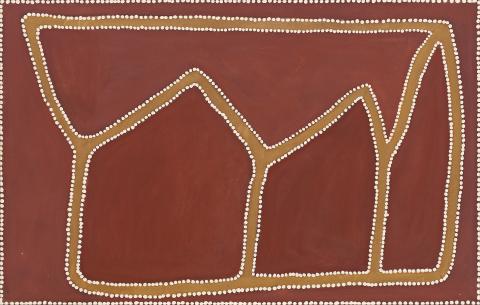GUWALIWALI COUNTRY, 1989
ROVER THOMAS (JOOLAMA)
natural earth pigments and synthetic binder on canvas
70.0 x 110.5 cm
bears inscription verso: artist’s name, size and Waringarri Arts catalogue nos. S-1989 and AP 1972
Waringarri Arts, Kununurra
Deutscher Gertrude Street, Melbourne
Private collection, Melbourne
Turkey Creek: Recent Work, Deutscher Gertrude Street, Melbourne, 25 October – 17 November 1989, cat. 5
Smoker, J., et al., Turkey Creek, Recent Work, exhibition catalogue, Deutscher Gertrude Street, Melbourne, 1989, p. 5 (illus.)
Painted in the year before Rover Thomas, along with Trevor Nickolls, became the first Aboriginal artists to represent Australia at the Venice Biennale, Guwaliwali, 1989 presents a plan view of the east Kimberley landscape where lines indicate paths travelled, tracks and roads, or delineate geographic features and circumscribe discreet areas of country. Characteristic of the Rover’s paintings, the conjunction of dotted lines simultaneously suggest a profile view, as though one were standing on the red-ochred earth looking at a distant hilly range.
The asymmetrical geometry of the composition is characteristic of Rover Thomas’s paintings although the angularity of the lines in this work is somewhat unusual. A similar orthogonal angularity appears in two large canvases that were painted in the same year and that were also shown in the Deutscher Gertrude Street exhibition of recent work from Turkey Creek in 1989: Dreamtime story of the willy willy, 1989, and Yari country, 1989, which is composed of a series of rectangles, were acquired from that exhibition by the National Gallery of Victoria.1
The exhibition featuring Guwaliwali was mounted by Waringarri Aboriginal Arts that had been established in 1986 in Kununurra to represent the Aboriginal artists of the region. In the exhibition catalogue, Joel Smoker, the art co-ordinator at Waringarri, records Rovers’ enthusiasm to paint. He describes Rover Thomas as being ‘very prolific’, having requested boards and eventually stretched canvases on which to paint, and that he could ‘never supply [Rover] as fast as he would like’.
1. see Ryan, J. and K. Akerman (eds.), Images of Power: Aboriginal art of the Kimberley, National Gallery of Victoria, Melbourne, 1993, pp. 60 and 61 respectively
WALLY CARUANA
